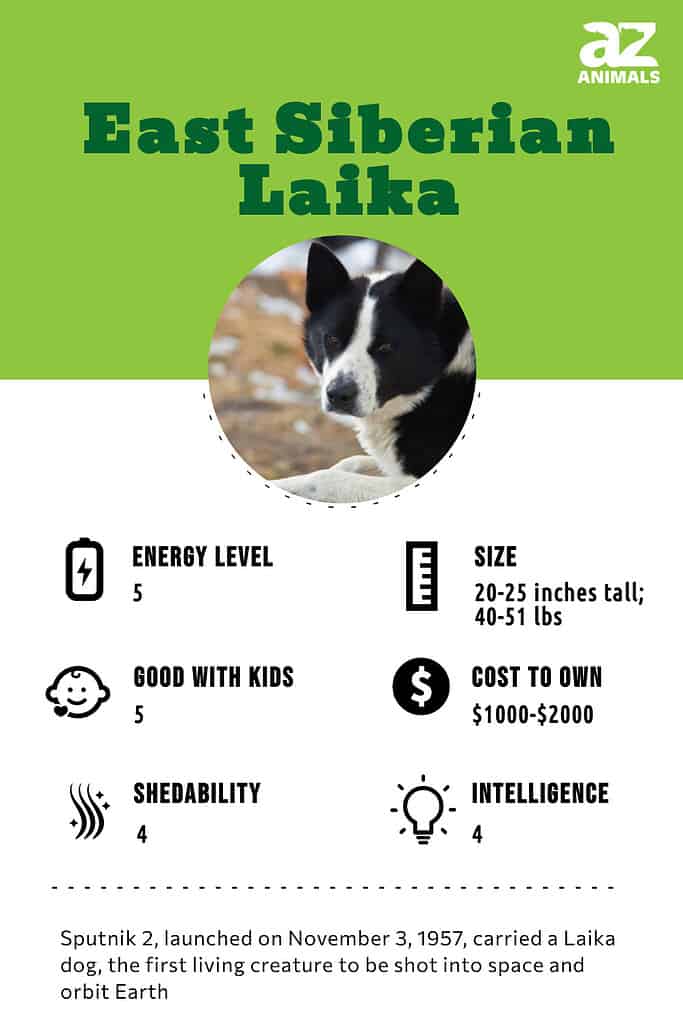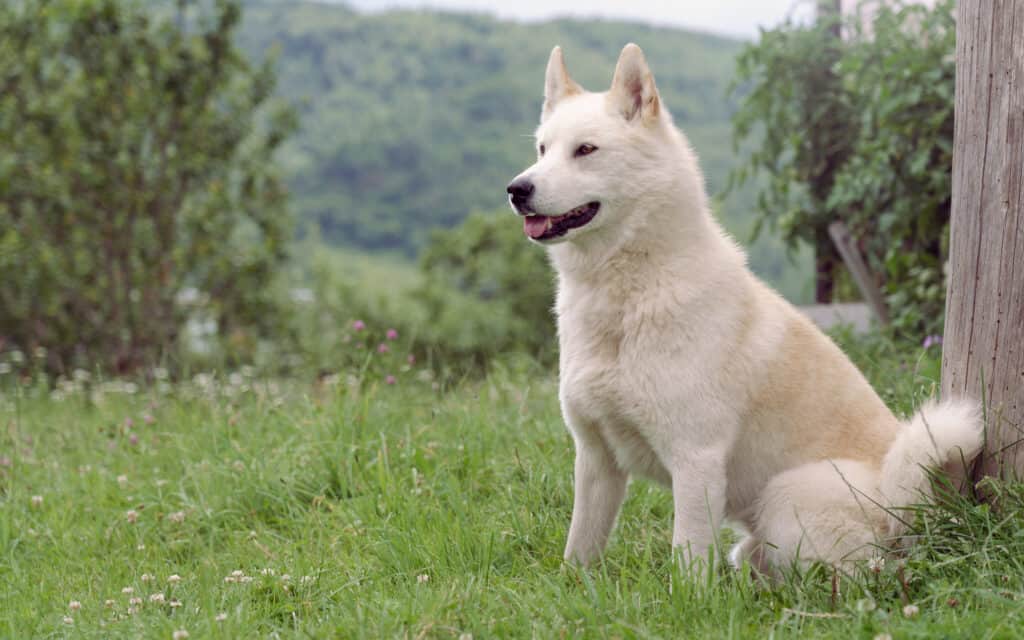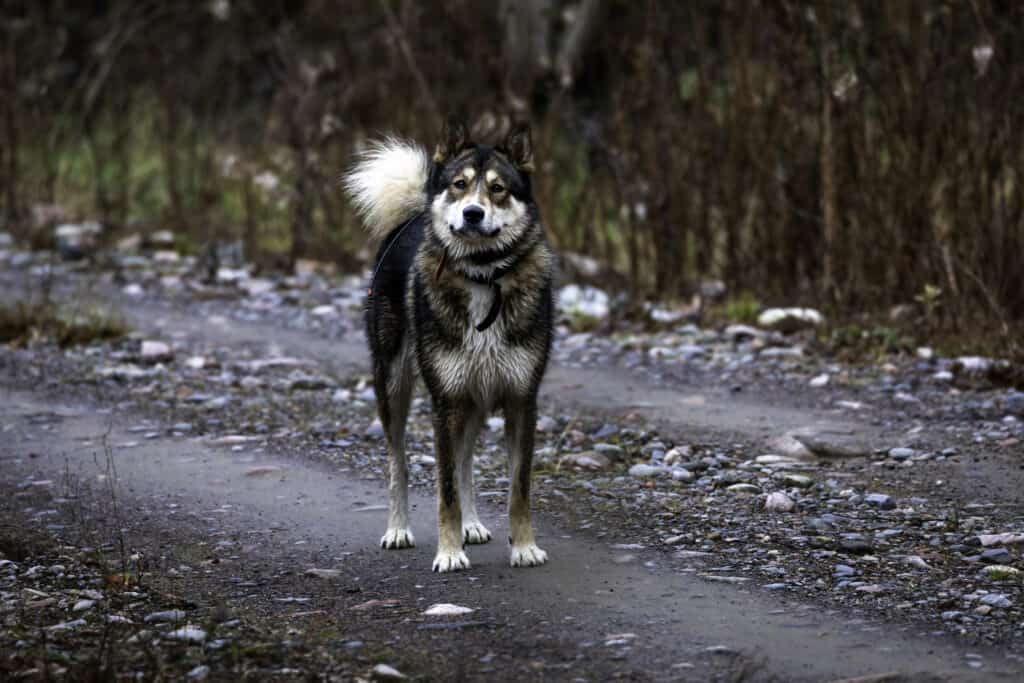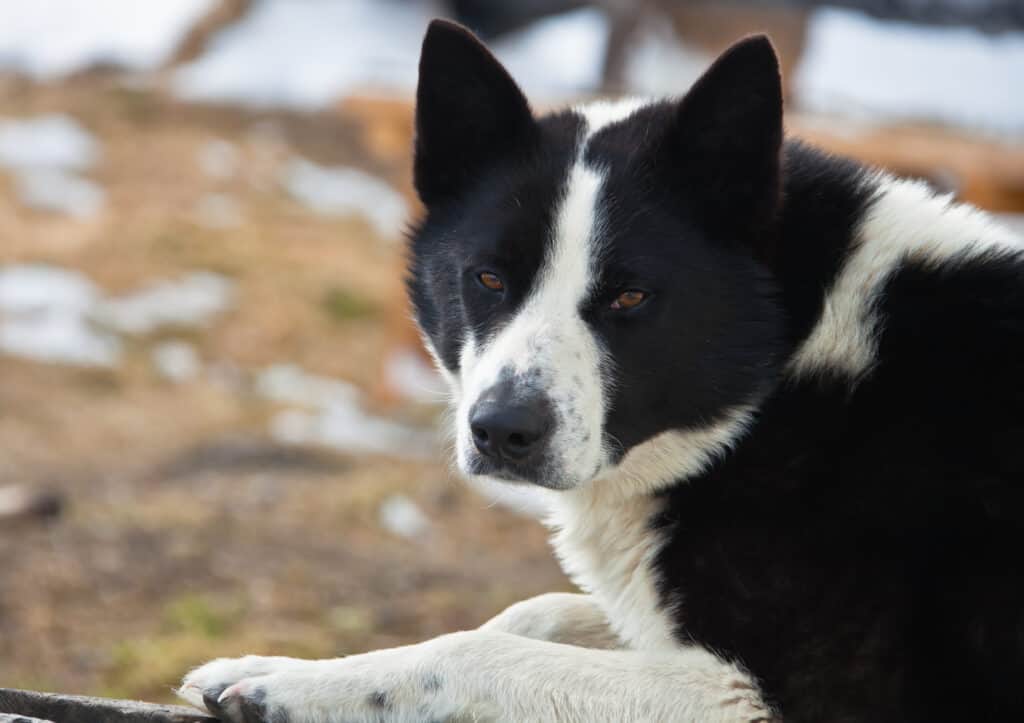East Siberian Laika
Canis Lupus
Because East Siberian Laikas are from a very cold region, they shed heavily and require a lot of grooming.
Advertisement
East Siberian Laika Scientific Classification
- Kingdom
- Animalia
- Phylum
- Chordata
- Class
- Mammalia
- Order
- Carnivora
- Family
- Canidae
- Genus
- Canis
- Scientific Name
- Canis Lupus
Read our Complete Guide to Classification of Animals.
East Siberian Laika Conservation Status
East Siberian Laika Facts
- Name Of Young
- Puppu
- Group Behavior
- Pack
- Fun Fact
- Because East Siberian Laikas are from a very cold region, they shed heavily and require a lot of grooming.
- Most Distinctive Feature
- Tail that curls over their back
- Distinctive Feature
- Curved tail
- Gestation Period
- 60-65 days
- Age Of Independence
- 6-12 months
- Litter Size
- 3-7
- Habitat
- Siberia
- Diet
- Omnivore
- Average Litter Size
- 3-7
- Lifestyle
- Pack
- Origin
- Eastern Siberia
- Location
- Eastern Siberia
View all of the East Siberian Laika images!
The East Siberian Laika is an amazing hunting dog that also makes a great companion!
5 East Siberian Laika Fun Facts
- The East Siberian Laika is the largest of all Russian Laika dog breeds.
- They bark much less than the other Laika breeds.
- They’re extremely calm and quiet for a hunting dog!
- The Siberian Laika isn’t your average urban dog and isn’t suited for an indoor environment.
- Originally bred to hunt, these canines have a strong prey drive. You could say that hunting is in their genes!

Introduction
The East Siberian Laika originated in Siberia in far eastern Russia. This breed belongs to the Spitz family of dogs, which are generally recognized as being the most closely related to wolves. Their name suggests that they are found on the ‘east’ side of the Jenisej river. The breed is rare in the US and western Europe. East Siberian Laikas acclimate easily to cold climates and are well-prepared for hunting. But this doesn’t mean they won’t make good pets. You can train them easily, especially if you take up a pup early on and socialize it well.
3 Pros And 3 Cons Of Owning East Siberian Laika
| Pros! | Cons! |
| Family-friendly. East Siberian Laikas are usually very sociable if they believe the family or the people around them are not a threat. So if you plan on keeping a puppy around, try socializing it with your kids as soon as possible. | Extremely Territorial. East Siberian Laikas often do not fare well when other animals are in the house, especially other dogs. So be wary if you have other dogs, cats, or rabbits in the house. |
| Easy to train. East Siberian Laikas are a highly intelligent breed with heightened senses and are easy to train. So once you start showing them how to follow your lead, getting them used to your commands would be fairly simple. | Not indoor friendly. East Siberian Laikas often require large, open spaces to thrive. Therefore, if you wish to keep one as a pet, holding them in an apartment setting would not be the best idea. Only keep them if you have an open space, such as a backyard. |
| Easy to Train. East Siberian Laikas are a highly intelligent breed with heightened senses and are easy to train. So once you start showing them how to follow your lead, getting them used to your commands would be fairly simple. | Problematic for allergy sufferers. East Siberian Laikas are hypoallergenic. This means that if you have any allergies, these canines are likely to trigger or flare those up. |
History Of The Breed
The East Siberian Laika originates from the Spitz-like Aboriginal dogs that were in all likelihood brought by tribes that were migrating from the west to the following areas of Siberia: Amur River basin, Baikal Lake region, Evenki National Territory, Irkutsk Province, and the Maritime Territory. They are an ancient breed, believed to be over 2000 years old, with fossils found dating back to the Neolithic period, which was 2200 to 10,000 years ago. It is believed that they may have come to Siberia with the migration of the Chinese and Mongolian people.
Types Of
In addition to the East Siberian Laika, there are four additional domestic breeds of the Laika:
- The Karel Laika – originated in Karelia, Russia.
- The Russian European Laika – originated between Finland and the Uralian mountains, mainly around Archangelsk, Komi Republic and Karelia.
- The West Siberian Laika – lighter body, more narrow head; from North Ural and West Siberia
- Yakutian Laika – from the Yakutia region of Siberia, Russia
Size And Weight

East Siberian Laikas are outdoor dogs that are a little larger than the average Siberian Husky.
©iStock.com/Ayman-Alakhras
The East Siberian Laika is a medium-to-large-sized dog, a little larger than the average Siberian Husky. Their males are often a bit taller than the females, capping at 26 inches. On average, the males and females weigh almost the same, ranging between 40-50 lbs.
| Height (Male) | 21 – 25’’ |
| Height (Female) | 20 – 24’’ |
| Weight (male) | 40 – 51 lbs |
| Weight (female) | 40 – 51 lbs |
The Best Dog Food For East Siberian Laikas
East Siberian Laikas were originally bred for hunting purposes. Therefore, their diet needs to be based heavily on protein to receive the same amount of nutrition they would if they were hunting in the wild. A dog food brand that seems to fulfill these needs as best as possible and is vet-recommended is HILL’S Science Diet – Adult Healthy Mobility. It meets the dog breed’s protein requirements and improves their hip and joint health to support their heavy build through its fish oil, glucosamine, and chondroitin content.
Common Health Issues
Like all other dog breeds, the East Siberian Laika has a few common health issues. Like many dog breeds, the most common is joint dysplasia, a genetic joint disease that causes arthritis and joint pain in dogs if left unaddressed. Then comes bloat, which is when your dog eats too much too fast, which causes its stomach to twist and trap blood within. Thus, their meals should always be spaced apart and small in quantity.
Common Ailments For This Canine Are:
- Hip Dysplasia
- Bloat or Gastric Volvulus
- Monorchidism – a testicular issue
- Eye Problems such as cherry eye, cataracts, lazy eye, etc.
Temperament
The East Siberian Laika has a hunting-fueled behavior. While they have evolved and adapted heavily, their behavior still shows several signs of their predisposed hunting traits. The dog’s common traits include territorial behavior, independence, and stubbornness. All these traits make them great watchdogs, but they can be challenging to train and socialize. Nevertheless, East Siberian Laikas are still quite friendly and show a lot of affection to their families. Once properly trained, they’ll make a lovely, courageous companion who will always protect you.
How To Take Care Of East Siberian Laikas

There is a common misconception that East Siberian Laikas would treat children as their prey because they are a hunting breed. The truth is quite the opposite of that.
©iStock.com/Armen Maitesyan
The East Siberian Laika is an outside dog breed that flourishes in large open spaces. So think twice before keeping it indoors. They require a protein-rich diet to mimic what their prey used to be in the wild. But overall, if you train them well and early, they’ll make a loyal and protective companion.
Maintenance And Grooming
East Liberian Laikas have a very dense, heavily layered coat that is well suited for the harsh winters of Siberia. They shed their hair often, another reason keeping them indoors might be problematic. Especially during the summer and fall seasons, these animals shed heavily, so be prepared with a heavy-duty vacuum. You must brush them daily during these seasons. In the colder months, even once a week should be okay. Use a pin brush, a slicker brush, or a metal comb to brush them, based on whatever suits your dog better.
In terms of bathing, you shouldn’t have to bathe them more than once or twice a year, unless they spend a lot of time outdoors and get especially dirty. Always use a mild shampoo and lather them thoroughly to remove any dirt in their dense fur. These canines also have hair between their toes and on their foot pads that should be trimmed every once in a while. Trim their toenails every few weeks and clean their ears once a week. They should not be shaved unless a vet recommends it.
Training

Since they were originally hunting dogs, this breed is very independent.
©iStock.com/August 19, 2019
Since they were originally hunting dogs, this breed is very independent. Therefore, the best approach would be to get a young puppy and start training it early. Training an East Siberian Laika requires a lot of patience and consistency from the owner. Thus, investing in a professional trainer would be a good idea if you have the time and resources.
Exercise
East Siberian Laikas are outdoor dogs that need ample protein intake. However, like all other dog breeds, they also need physical activity to burn off any excess food and prevent bloat. Hence, the East Siberian Laika requires at least one hour of daily exercise and a few long walks. However, you won’t want to take them to a dog park as they do not enjoy the company of other dogs and may become aggressive. A hike or a dog sport such as cart pulling would be better.
Puppies
East Siberian Laikas have an average litter size of 6-10 puppies. If you plan on adopting a puppy, you must vaccinate them at 16 weeks.
East Siberian Laika puppies are much easier to train than adults. So it would be best if you could acclimate the puppy with your family and close friends from a young age. That way, there’s a much lower chance of any aggressive or erratic behavior coming out later in the Laika’s life.
East Siberian Laikas And Children
There is a common misconception that East Siberian Laikas would treat children as their prey because they are a hunting breed. The truth is quite the opposite of that. East Siberian Laikas are very friendly, protective, and playful with kids. Just ensure that you introduce East Siberian Laika puppies to your family early.
Popular Names for East Siberian Laikas
- Buddy
- Max
- Murphy
- Molly
- Bella
- Lady
Dogs Similar To East Siberian Laikas
View all 117 animals that start with EEast Siberian Laika FAQs (Frequently Asked Questions)
How much do East Siberian Laikas cost to own?
The initial cost of an East Siberian Laika is about $1,000. The monthly costs that follow are about $35-45, depending on the quality of the food, grooming, etc.
Are East Siberian Laikas good with kids?
Even though they were initially hunting dogs, East Siberian Laikas are great with kids.
How long do East Siberian Laikas live?
East Siberian Laikas live between 12 to 15 years.
How are the East and West Siberian Laikas different?
The East Siberian Laikas are larger than the West ones in height and weight alike. East Siberian Laikas also have a much thicker and harsher coat than the West Siberian Laikas.
Difference between East Siberian Laikas and Siberian Huskys?
Laikas and Huskys are very similar dog breeds, but East Siberian Laikas are generally a bit larger both in height and weight. Siberian Huskies have a fluffy coat while East Siberian Laikas have a straight harsh coat. Siberian Huskies also have much bushier tails.
Thank you for reading! Have some feedback for us? Contact the AZ Animals editorial team.

















